BM522 Project Management: Transport for London Detailed Case Study
VerifiedAdded on 2023/06/17
|17
|2217
|162
Case Study
AI Summary
This report provides a comprehensive analysis of project management at Transport for London (TfL), focusing on a project to develop 800 new homes in Acton. It examines various project management methodologies, including Waterfall and Agile techniques, and their application within TfL. The report includes a stakeholder analysis, identifying key stakeholders and their levels of power and interest. A work breakdown structure (WBS) is presented to illustrate the project's tasks and deliverables, and a risk analysis identifies potential issues and mitigation strategies. The report also includes a network diagram and Gantt chart for project scheduling and visualization. The analysis provides insights into how project management principles are applied within a complex organization like TfL to achieve its strategic objectives. Desklib provides access to similar solved assignments for students.
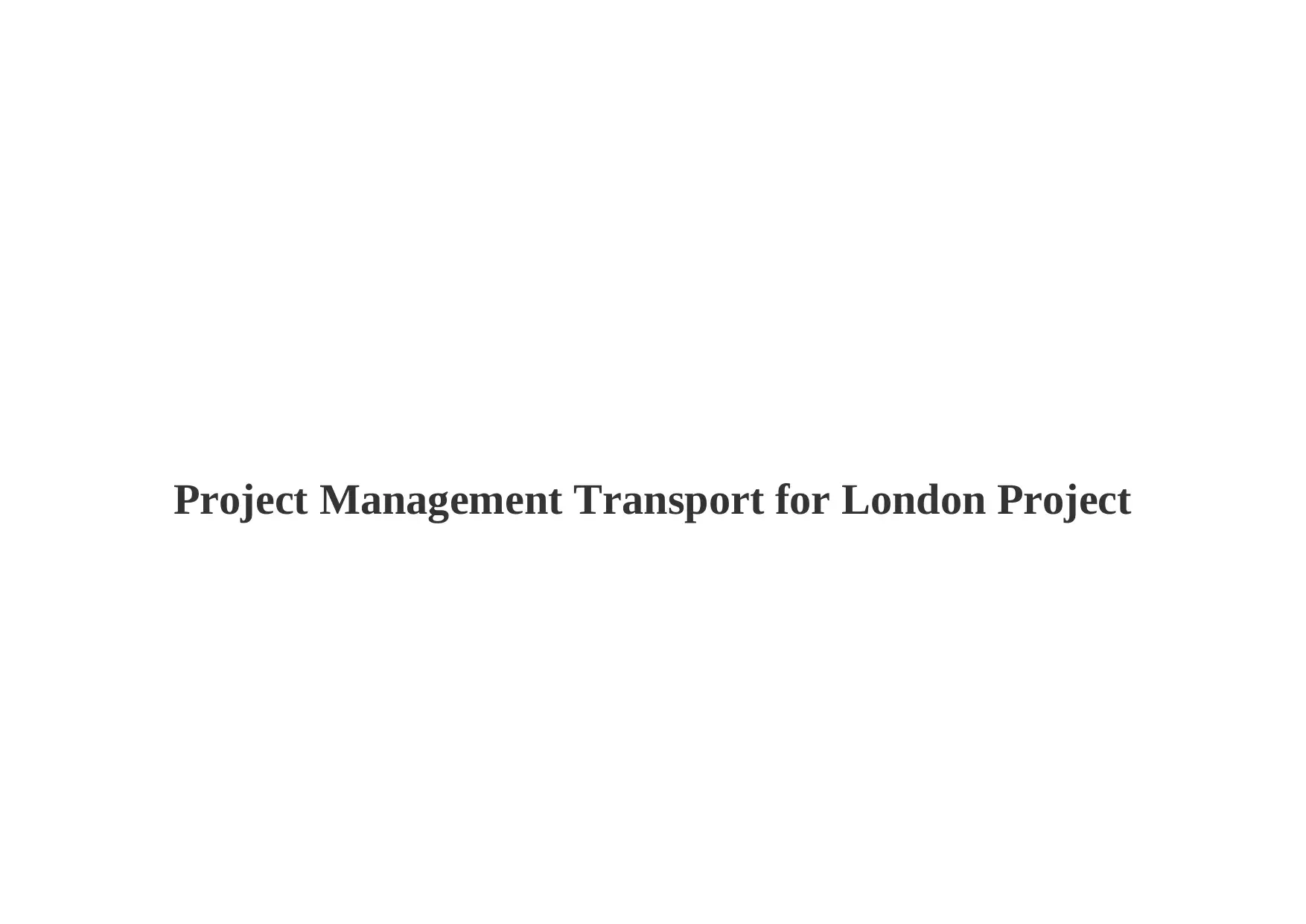
Project Management Transport for London Project
Paraphrase This Document
Need a fresh take? Get an instant paraphrase of this document with our AI Paraphraser
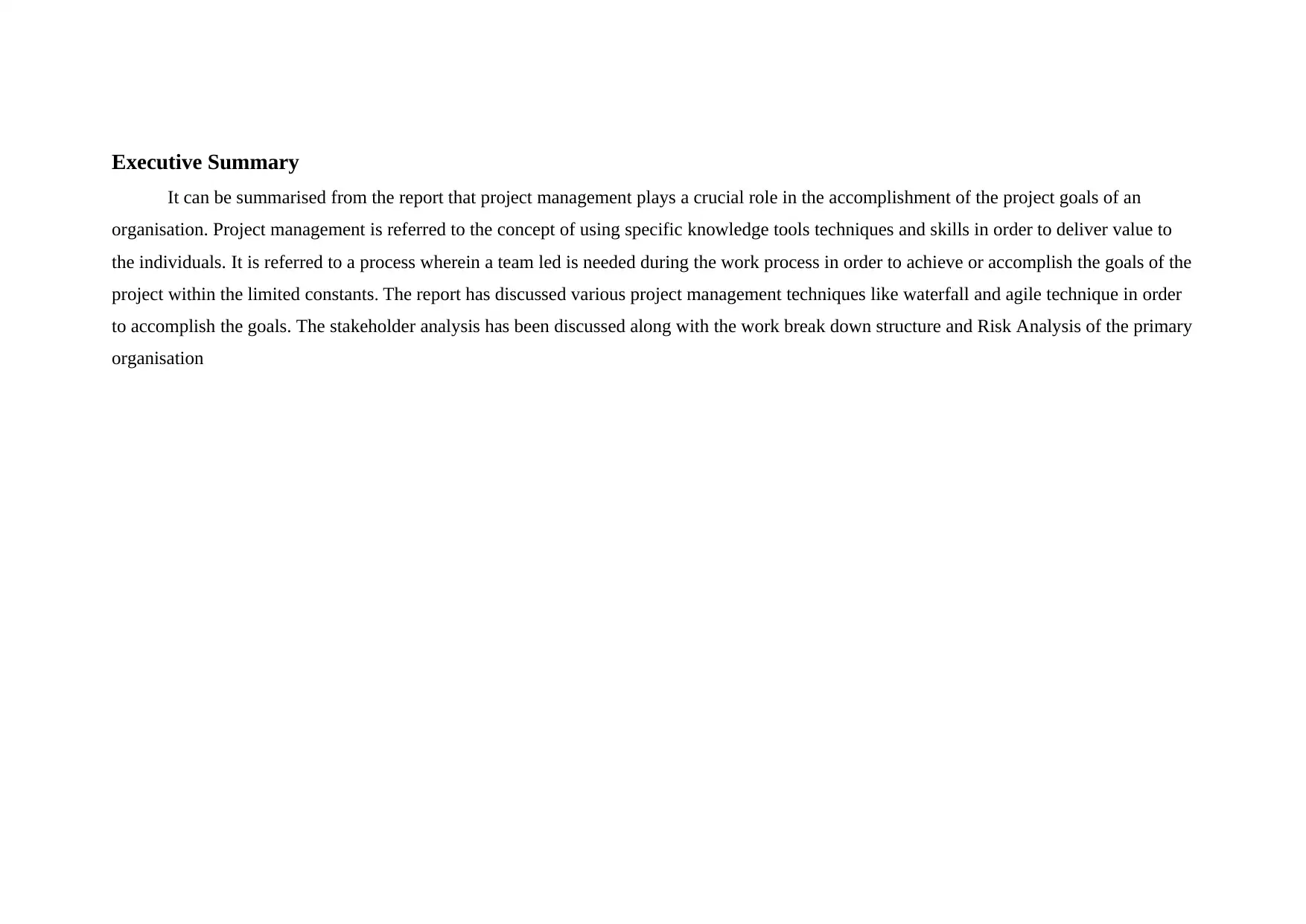
Executive Summary
It can be summarised from the report that project management plays a crucial role in the accomplishment of the project goals of an
organisation. Project management is referred to the concept of using specific knowledge tools techniques and skills in order to deliver value to
the individuals. It is referred to a process wherein a team led is needed during the work process in order to achieve or accomplish the goals of the
project within the limited constants. The report has discussed various project management techniques like waterfall and agile technique in order
to accomplish the goals. The stakeholder analysis has been discussed along with the work break down structure and Risk Analysis of the primary
organisation
It can be summarised from the report that project management plays a crucial role in the accomplishment of the project goals of an
organisation. Project management is referred to the concept of using specific knowledge tools techniques and skills in order to deliver value to
the individuals. It is referred to a process wherein a team led is needed during the work process in order to achieve or accomplish the goals of the
project within the limited constants. The report has discussed various project management techniques like waterfall and agile technique in order
to accomplish the goals. The stakeholder analysis has been discussed along with the work break down structure and Risk Analysis of the primary
organisation

Table of Contents
Executive Summary....................................................................................................................................................................................................................... 2
Introduction................................................................................................................................................................................................................................... 4
Task 1............................................................................................................................................................................................................................................ 4
Task 2............................................................................................................................................................................................................................................ 5
Task 3............................................................................................................................................................................................................................................ 9
Task 4.......................................................................................................................................................................................................................................... 10
Task 5.......................................................................................................................................................................................................................................... 13
Task 6.......................................................................................................................................................................................................................................... 14
Conclusion................................................................................................................................................................................................................................... 15
References................................................................................................................................................................................................................................... 16
Executive Summary....................................................................................................................................................................................................................... 2
Introduction................................................................................................................................................................................................................................... 4
Task 1............................................................................................................................................................................................................................................ 4
Task 2............................................................................................................................................................................................................................................ 5
Task 3............................................................................................................................................................................................................................................ 9
Task 4.......................................................................................................................................................................................................................................... 10
Task 5.......................................................................................................................................................................................................................................... 13
Task 6.......................................................................................................................................................................................................................................... 14
Conclusion................................................................................................................................................................................................................................... 15
References................................................................................................................................................................................................................................... 16
⊘ This is a preview!⊘
Do you want full access?
Subscribe today to unlock all pages.

Trusted by 1+ million students worldwide
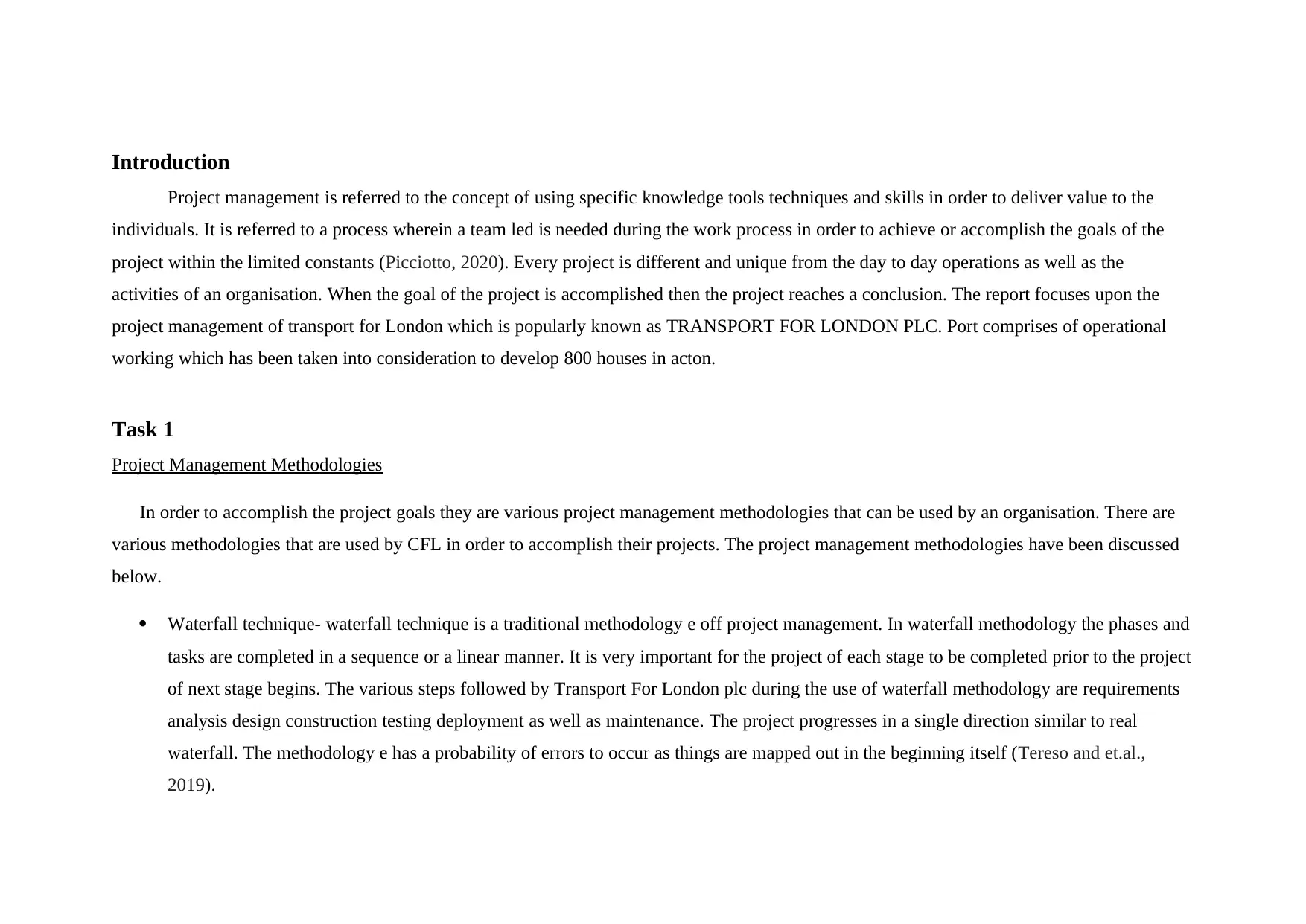
Introduction
Project management is referred to the concept of using specific knowledge tools techniques and skills in order to deliver value to the
individuals. It is referred to a process wherein a team led is needed during the work process in order to achieve or accomplish the goals of the
project within the limited constants (Picciotto, 2020). Every project is different and unique from the day to day operations as well as the
activities of an organisation. When the goal of the project is accomplished then the project reaches a conclusion. The report focuses upon the
project management of transport for London which is popularly known as TRANSPORT FOR LONDON PLC. Port comprises of operational
working which has been taken into consideration to develop 800 houses in acton.
Task 1
Project Management Methodologies
In order to accomplish the project goals they are various project management methodologies that can be used by an organisation. There are
various methodologies that are used by CFL in order to accomplish their projects. The project management methodologies have been discussed
below.
Waterfall technique- waterfall technique is a traditional methodology e off project management. In waterfall methodology the phases and
tasks are completed in a sequence or a linear manner. It is very important for the project of each stage to be completed prior to the project
of next stage begins. The various steps followed by Transport For London plc during the use of waterfall methodology are requirements
analysis design construction testing deployment as well as maintenance. The project progresses in a single direction similar to real
waterfall. The methodology e has a probability of errors to occur as things are mapped out in the beginning itself (Tereso and et.al.,
2019).
Project management is referred to the concept of using specific knowledge tools techniques and skills in order to deliver value to the
individuals. It is referred to a process wherein a team led is needed during the work process in order to achieve or accomplish the goals of the
project within the limited constants (Picciotto, 2020). Every project is different and unique from the day to day operations as well as the
activities of an organisation. When the goal of the project is accomplished then the project reaches a conclusion. The report focuses upon the
project management of transport for London which is popularly known as TRANSPORT FOR LONDON PLC. Port comprises of operational
working which has been taken into consideration to develop 800 houses in acton.
Task 1
Project Management Methodologies
In order to accomplish the project goals they are various project management methodologies that can be used by an organisation. There are
various methodologies that are used by CFL in order to accomplish their projects. The project management methodologies have been discussed
below.
Waterfall technique- waterfall technique is a traditional methodology e off project management. In waterfall methodology the phases and
tasks are completed in a sequence or a linear manner. It is very important for the project of each stage to be completed prior to the project
of next stage begins. The various steps followed by Transport For London plc during the use of waterfall methodology are requirements
analysis design construction testing deployment as well as maintenance. The project progresses in a single direction similar to real
waterfall. The methodology e has a probability of errors to occur as things are mapped out in the beginning itself (Tereso and et.al.,
2019).
Paraphrase This Document
Need a fresh take? Get an instant paraphrase of this document with our AI Paraphraser
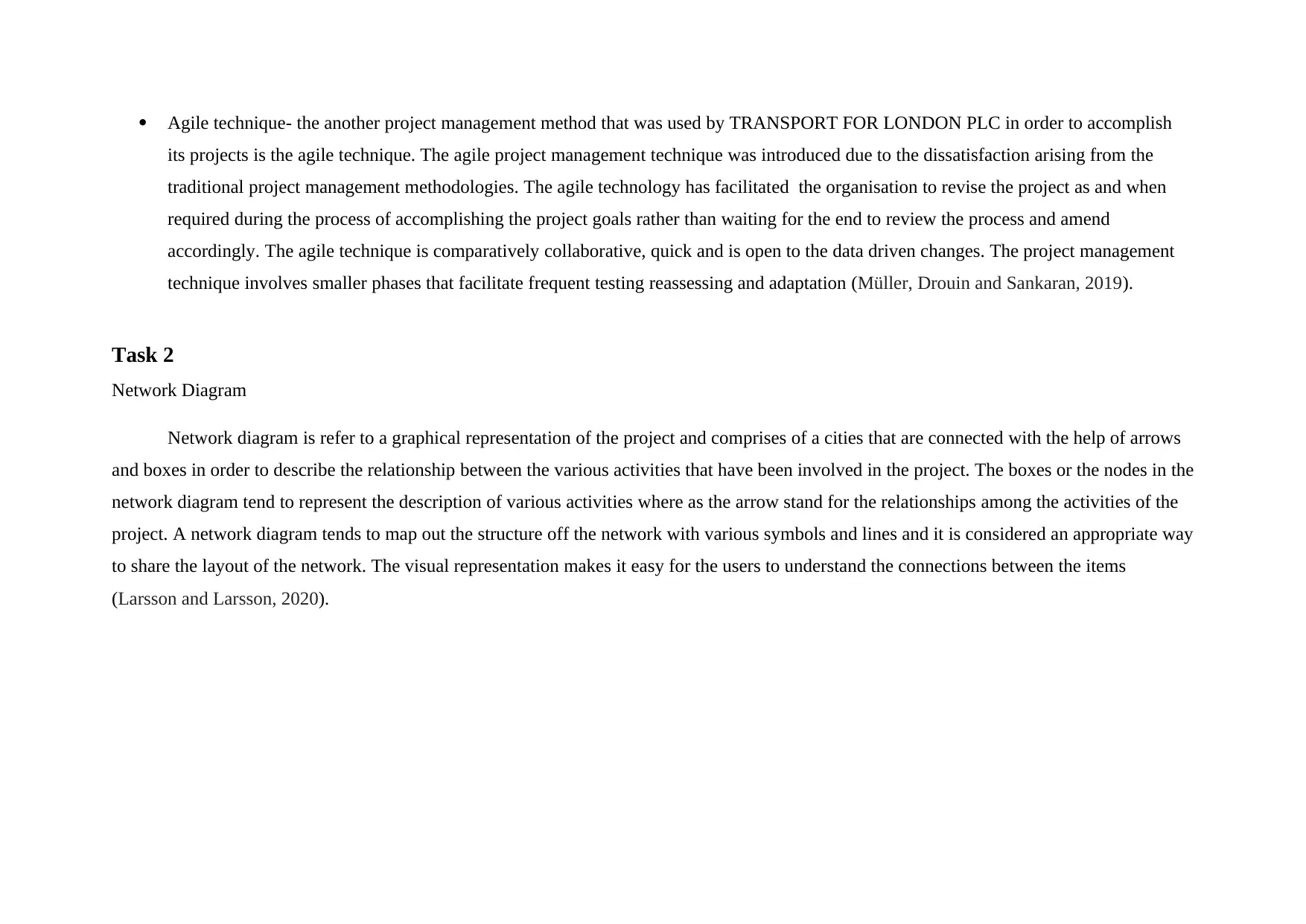
Agile technique- the another project management method that was used by TRANSPORT FOR LONDON PLC in order to accomplish
its projects is the agile technique. The agile project management technique was introduced due to the dissatisfaction arising from the
traditional project management methodologies. The agile technology has facilitated the organisation to revise the project as and when
required during the process of accomplishing the project goals rather than waiting for the end to review the process and amend
accordingly. The agile technique is comparatively collaborative, quick and is open to the data driven changes. The project management
technique involves smaller phases that facilitate frequent testing reassessing and adaptation (Müller, Drouin and Sankaran, 2019).
Task 2
Network Diagram
Network diagram is refer to a graphical representation of the project and comprises of a cities that are connected with the help of arrows
and boxes in order to describe the relationship between the various activities that have been involved in the project. The boxes or the nodes in the
network diagram tend to represent the description of various activities where as the arrow stand for the relationships among the activities of the
project. A network diagram tends to map out the structure off the network with various symbols and lines and it is considered an appropriate way
to share the layout of the network. The visual representation makes it easy for the users to understand the connections between the items
(Larsson and Larsson, 2020).
its projects is the agile technique. The agile project management technique was introduced due to the dissatisfaction arising from the
traditional project management methodologies. The agile technology has facilitated the organisation to revise the project as and when
required during the process of accomplishing the project goals rather than waiting for the end to review the process and amend
accordingly. The agile technique is comparatively collaborative, quick and is open to the data driven changes. The project management
technique involves smaller phases that facilitate frequent testing reassessing and adaptation (Müller, Drouin and Sankaran, 2019).
Task 2
Network Diagram
Network diagram is refer to a graphical representation of the project and comprises of a cities that are connected with the help of arrows
and boxes in order to describe the relationship between the various activities that have been involved in the project. The boxes or the nodes in the
network diagram tend to represent the description of various activities where as the arrow stand for the relationships among the activities of the
project. A network diagram tends to map out the structure off the network with various symbols and lines and it is considered an appropriate way
to share the layout of the network. The visual representation makes it easy for the users to understand the connections between the items
(Larsson and Larsson, 2020).
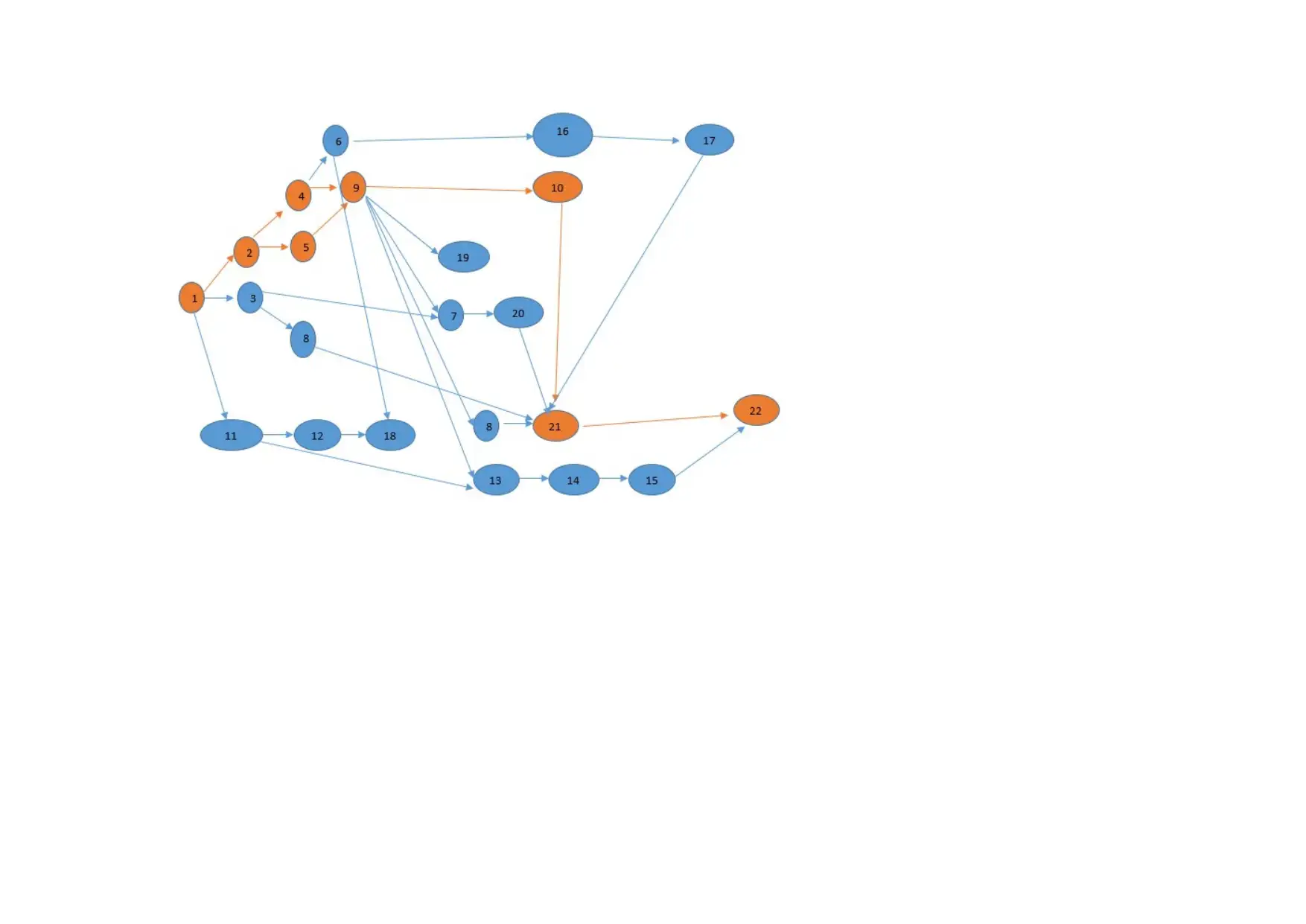
⊘ This is a preview!⊘
Do you want full access?
Subscribe today to unlock all pages.

Trusted by 1+ million students worldwide
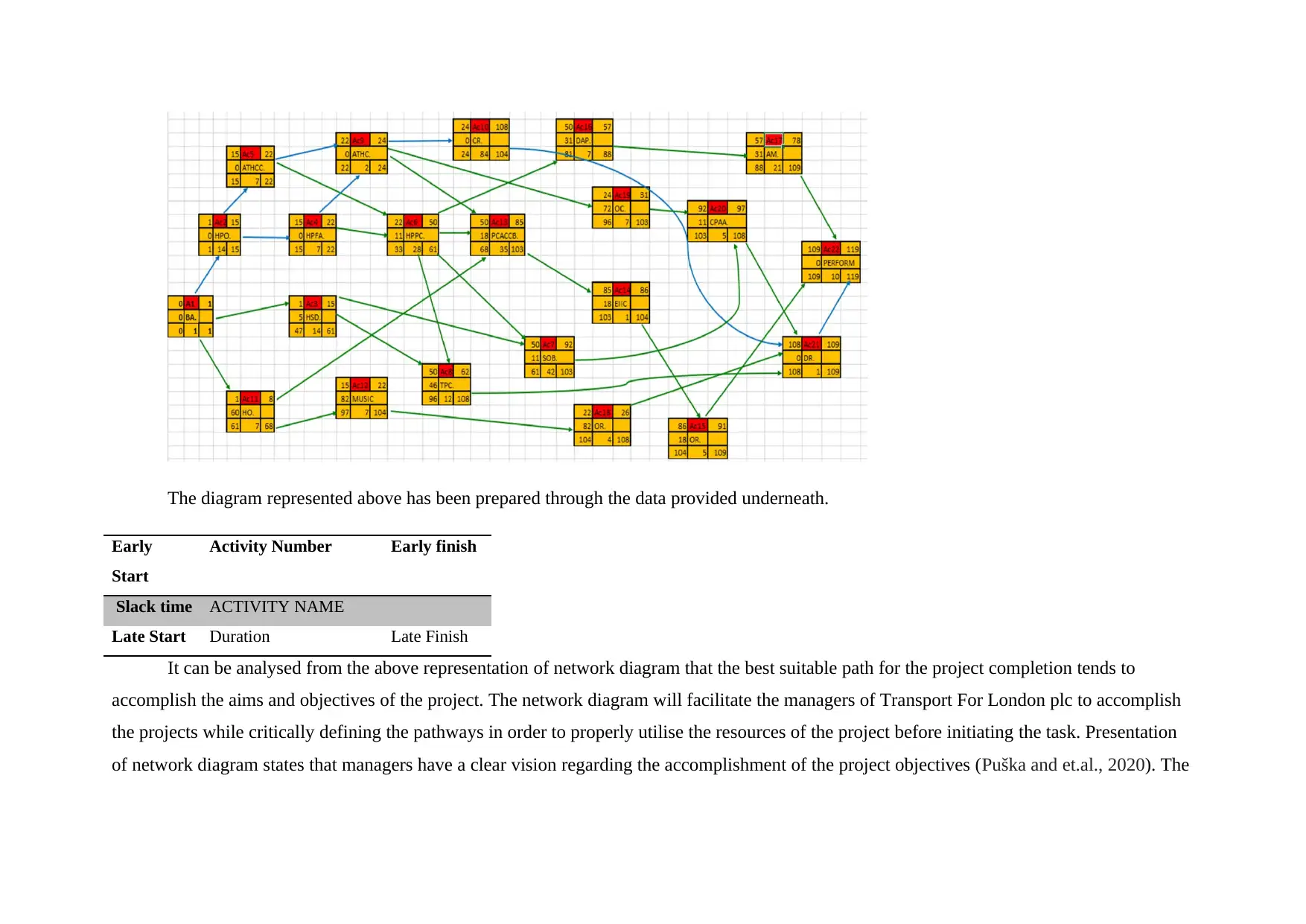
The diagram represented above has been prepared through the data provided underneath.
Early
Start
Activity Number Early finish
Slack time ACTIVITY NAME
Late Start Duration Late Finish
It can be analysed from the above representation of network diagram that the best suitable path for the project completion tends to
accomplish the aims and objectives of the project. The network diagram will facilitate the managers of Transport For London plc to accomplish
the projects while critically defining the pathways in order to properly utilise the resources of the project before initiating the task. Presentation
of network diagram states that managers have a clear vision regarding the accomplishment of the project objectives (Puška and et.al., 2020). The
Early
Start
Activity Number Early finish
Slack time ACTIVITY NAME
Late Start Duration Late Finish
It can be analysed from the above representation of network diagram that the best suitable path for the project completion tends to
accomplish the aims and objectives of the project. The network diagram will facilitate the managers of Transport For London plc to accomplish
the projects while critically defining the pathways in order to properly utilise the resources of the project before initiating the task. Presentation
of network diagram states that managers have a clear vision regarding the accomplishment of the project objectives (Puška and et.al., 2020). The
Paraphrase This Document
Need a fresh take? Get an instant paraphrase of this document with our AI Paraphraser
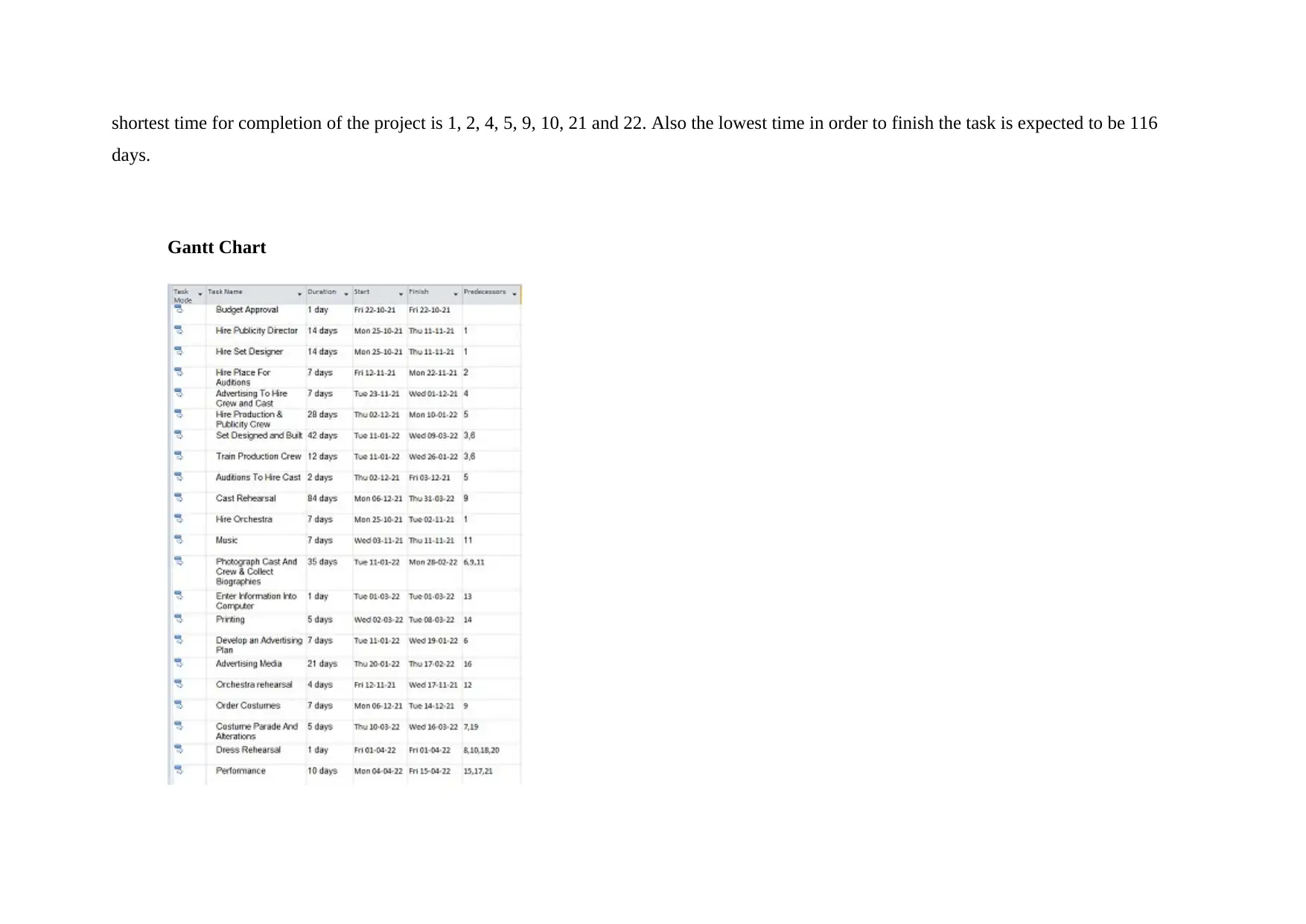
shortest time for completion of the project is 1, 2, 4, 5, 9, 10, 21 and 22. Also the lowest time in order to finish the task is expected to be 116
days.
Gantt Chart
days.
Gantt Chart
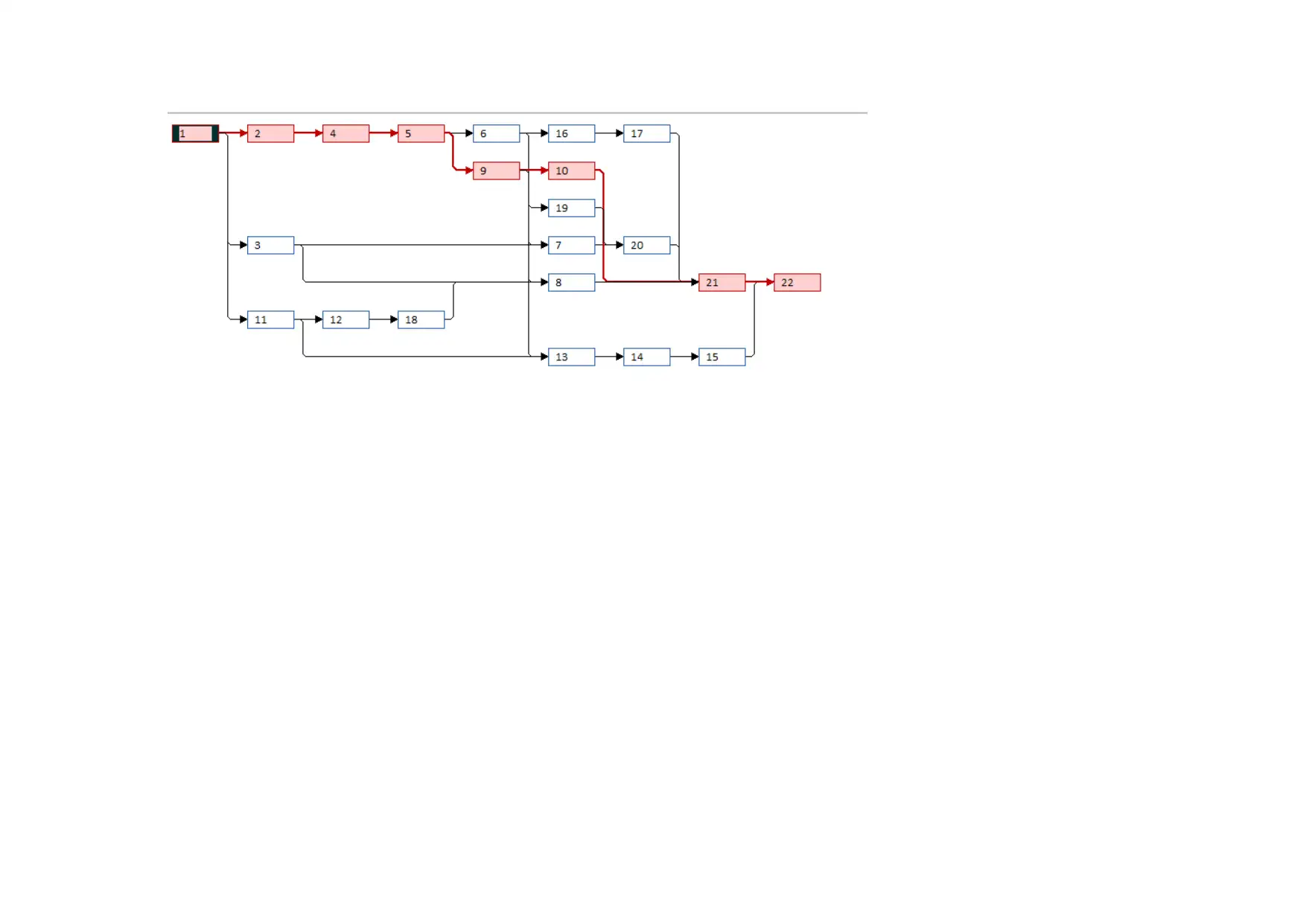
⊘ This is a preview!⊘
Do you want full access?
Subscribe today to unlock all pages.

Trusted by 1+ million students worldwide
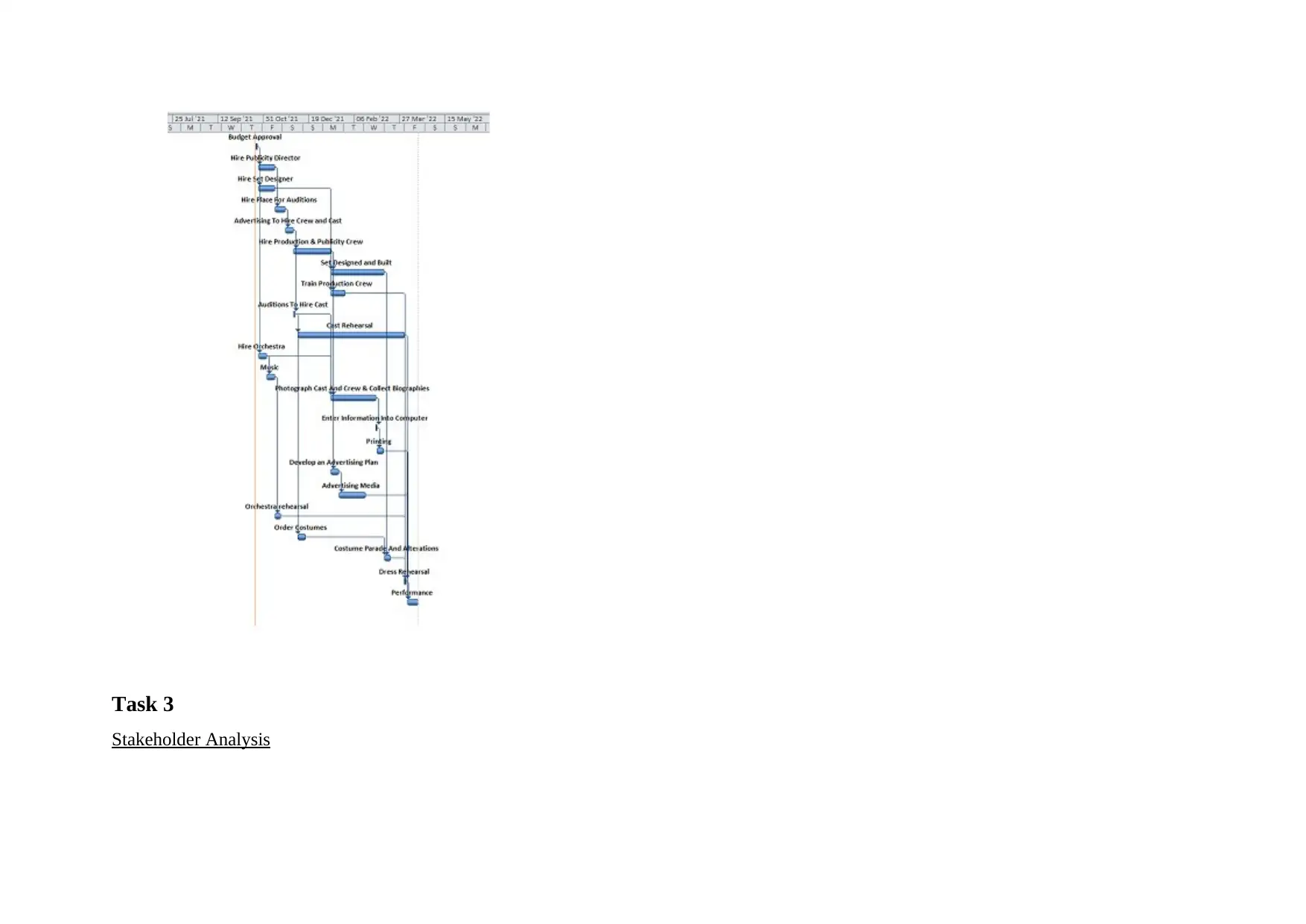
Task 3
Stakeholder Analysis
Stakeholder Analysis
Paraphrase This Document
Need a fresh take? Get an instant paraphrase of this document with our AI Paraphraser
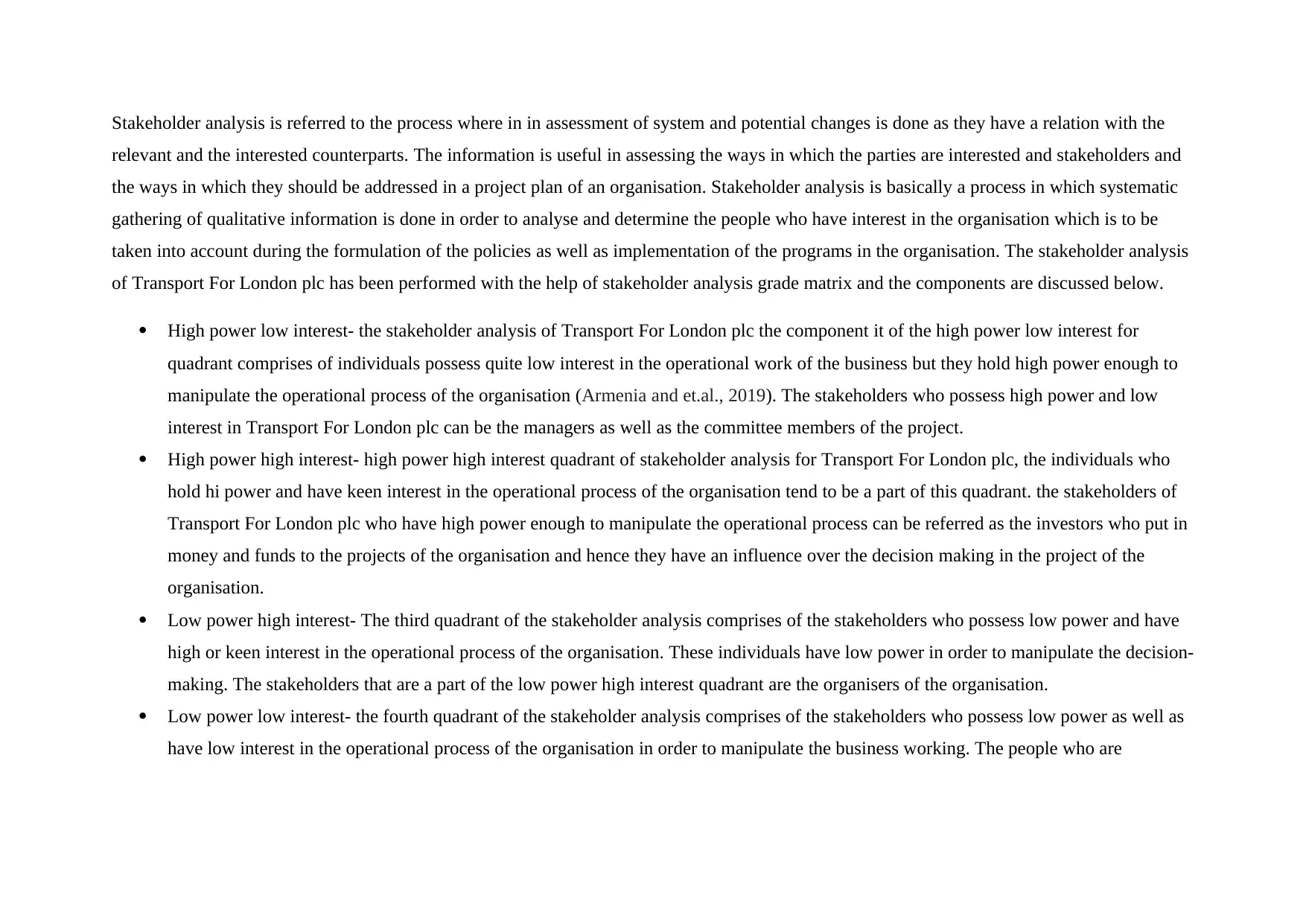
Stakeholder analysis is referred to the process where in in assessment of system and potential changes is done as they have a relation with the
relevant and the interested counterparts. The information is useful in assessing the ways in which the parties are interested and stakeholders and
the ways in which they should be addressed in a project plan of an organisation. Stakeholder analysis is basically a process in which systematic
gathering of qualitative information is done in order to analyse and determine the people who have interest in the organisation which is to be
taken into account during the formulation of the policies as well as implementation of the programs in the organisation. The stakeholder analysis
of Transport For London plc has been performed with the help of stakeholder analysis grade matrix and the components are discussed below.
High power low interest- the stakeholder analysis of Transport For London plc the component it of the high power low interest for
quadrant comprises of individuals possess quite low interest in the operational work of the business but they hold high power enough to
manipulate the operational process of the organisation (Armenia and et.al., 2019). The stakeholders who possess high power and low
interest in Transport For London plc can be the managers as well as the committee members of the project.
High power high interest- high power high interest quadrant of stakeholder analysis for Transport For London plc, the individuals who
hold hi power and have keen interest in the operational process of the organisation tend to be a part of this quadrant. the stakeholders of
Transport For London plc who have high power enough to manipulate the operational process can be referred as the investors who put in
money and funds to the projects of the organisation and hence they have an influence over the decision making in the project of the
organisation.
Low power high interest- The third quadrant of the stakeholder analysis comprises of the stakeholders who possess low power and have
high or keen interest in the operational process of the organisation. These individuals have low power in order to manipulate the decision-
making. The stakeholders that are a part of the low power high interest quadrant are the organisers of the organisation.
Low power low interest- the fourth quadrant of the stakeholder analysis comprises of the stakeholders who possess low power as well as
have low interest in the operational process of the organisation in order to manipulate the business working. The people who are
relevant and the interested counterparts. The information is useful in assessing the ways in which the parties are interested and stakeholders and
the ways in which they should be addressed in a project plan of an organisation. Stakeholder analysis is basically a process in which systematic
gathering of qualitative information is done in order to analyse and determine the people who have interest in the organisation which is to be
taken into account during the formulation of the policies as well as implementation of the programs in the organisation. The stakeholder analysis
of Transport For London plc has been performed with the help of stakeholder analysis grade matrix and the components are discussed below.
High power low interest- the stakeholder analysis of Transport For London plc the component it of the high power low interest for
quadrant comprises of individuals possess quite low interest in the operational work of the business but they hold high power enough to
manipulate the operational process of the organisation (Armenia and et.al., 2019). The stakeholders who possess high power and low
interest in Transport For London plc can be the managers as well as the committee members of the project.
High power high interest- high power high interest quadrant of stakeholder analysis for Transport For London plc, the individuals who
hold hi power and have keen interest in the operational process of the organisation tend to be a part of this quadrant. the stakeholders of
Transport For London plc who have high power enough to manipulate the operational process can be referred as the investors who put in
money and funds to the projects of the organisation and hence they have an influence over the decision making in the project of the
organisation.
Low power high interest- The third quadrant of the stakeholder analysis comprises of the stakeholders who possess low power and have
high or keen interest in the operational process of the organisation. These individuals have low power in order to manipulate the decision-
making. The stakeholders that are a part of the low power high interest quadrant are the organisers of the organisation.
Low power low interest- the fourth quadrant of the stakeholder analysis comprises of the stakeholders who possess low power as well as
have low interest in the operational process of the organisation in order to manipulate the business working. The people who are
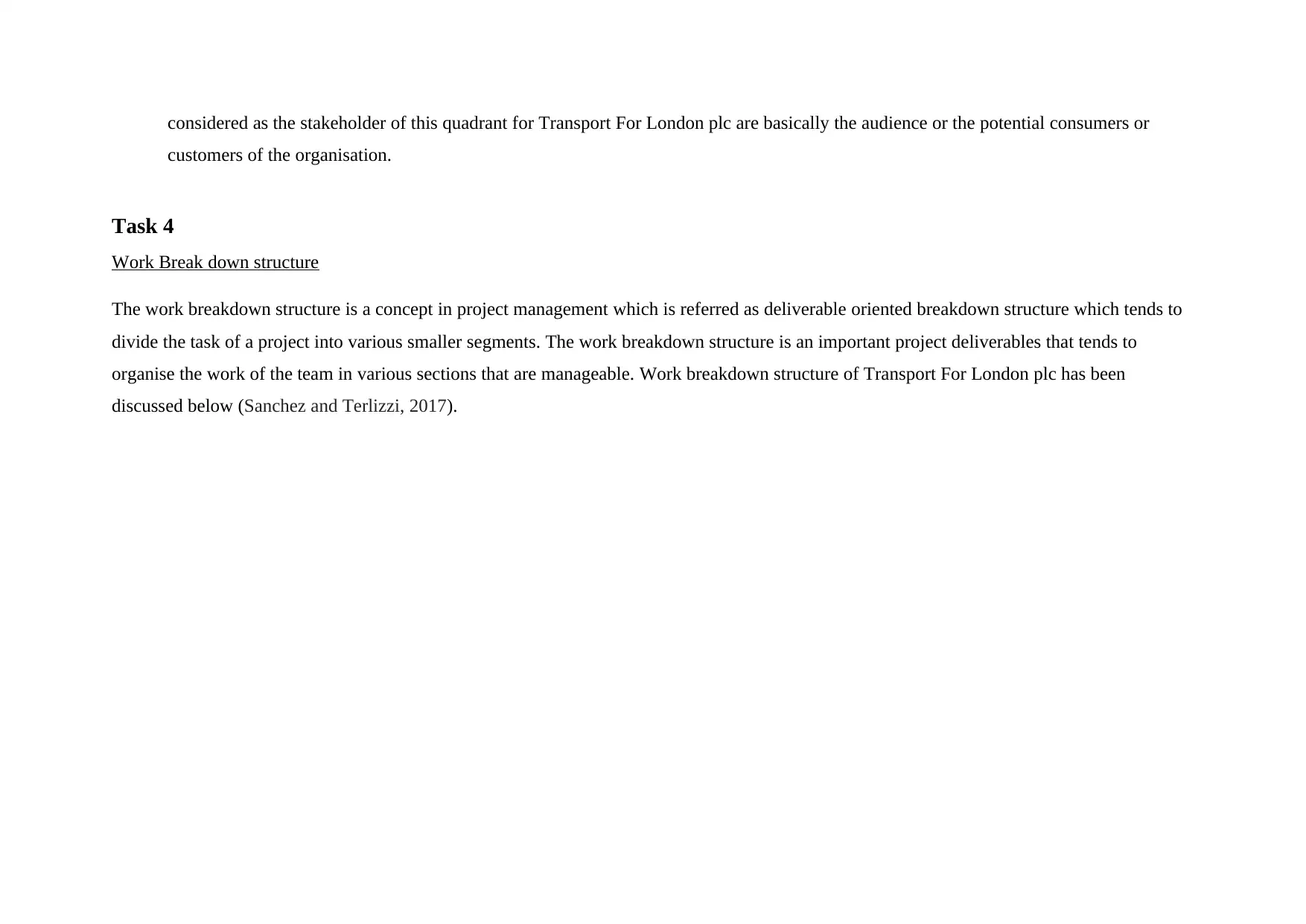
considered as the stakeholder of this quadrant for Transport For London plc are basically the audience or the potential consumers or
customers of the organisation.
Task 4
Work Break down structure
The work breakdown structure is a concept in project management which is referred as deliverable oriented breakdown structure which tends to
divide the task of a project into various smaller segments. The work breakdown structure is an important project deliverables that tends to
organise the work of the team in various sections that are manageable. Work breakdown structure of Transport For London plc has been
discussed below (Sanchez and Terlizzi, 2017).
customers of the organisation.
Task 4
Work Break down structure
The work breakdown structure is a concept in project management which is referred as deliverable oriented breakdown structure which tends to
divide the task of a project into various smaller segments. The work breakdown structure is an important project deliverables that tends to
organise the work of the team in various sections that are manageable. Work breakdown structure of Transport For London plc has been
discussed below (Sanchez and Terlizzi, 2017).
⊘ This is a preview!⊘
Do you want full access?
Subscribe today to unlock all pages.

Trusted by 1+ million students worldwide
1 out of 17
Related Documents
Your All-in-One AI-Powered Toolkit for Academic Success.
+13062052269
info@desklib.com
Available 24*7 on WhatsApp / Email
![[object Object]](/_next/static/media/star-bottom.7253800d.svg)
Unlock your academic potential
Copyright © 2020–2025 A2Z Services. All Rights Reserved. Developed and managed by ZUCOL.
